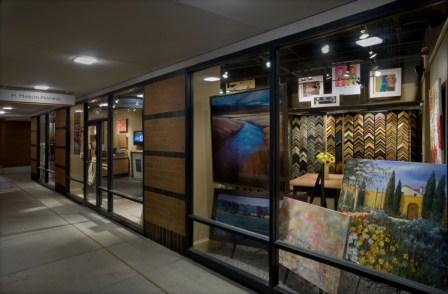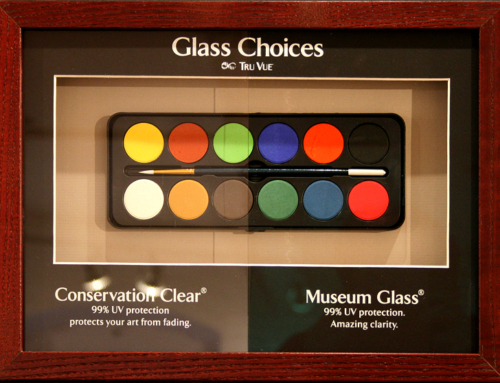By Alyssa Taylor
The choice of frames on artwork makes a strong impact in the design of your home.
Jan Marion of H. Marion Framing and his team of designers have been in the framing business for over thirty years and has acquired a lot of useful knowledge on the subject.

Lead Design staff of H. Marion Framing at the grand opening of their new frame studio in Wilmette’s Edens Plaza.
“There are certain techniques and materials that need to be used so that your art will last,” he says. “Both from a preservation standpoint but also from a quality of raw materials, we need to make sure that your piece will look as good in 5, 10, 50 years as it does the day you pick it up in the frame shop.”
When framing a collection of prints, drawings, or photographs, it’s wise to frame all of the pieces in similar profiles, giving the collection more impact, drawing attention to the work itself.
Many designers select simple black, ebonized frame profiles or a soft nickel or gold-leaf finish.
Marion explains that frames should complement their environment, as well as the art they hold. “From a design standpoint, our frames are seen as an interior finish,” he said. “A home that has exquisite finishes like hardwood, granite, real stone, custom millwork and designer furniture should have art and framing of a consistent quality.”
In their new Wilmette showroom Marion and his head designer, Pam Rosenberg offer numerous options for frame moldings and pictures.
“We frame in all shape, color, and sizes finding a harmonious element in the frame styles, color and scale for the appropriate sized wall and location. Family portraits, whether an entire family or one individual, can even be the focal art piece in a room,” Rosenberg explains.
A great way to show off your family photos, consider placing them all together on a large wall. Sentimental family photographs look great clustered together.
If you are working on a more modern look, keep the frames clean and simple.
If your home is more traditional, carved wood frames work well. “Photos are popular because they aren’t just an 8 x 10 anymore they are plumped full of design and interest.”
Sometimes, it’s hard to justify the expense of custom framing on a print with unknown, if any value. However, if you love the piece, it’s worth the investment.
“We don’t know today what may be valuable in 50 years,” Marion says. ” A good example is vintage movie posters. When published initially, they were intended as short term display and to be thrown away. Today a good original can fetch in the tens of thousands. For that reason it’s smart to treat everything in a conservation minded way.”
Even those throw-away relics of childhood, when cared for, can become family heirlooms.
“We recently framed a client’s third grade clarinet, complete with sheets of music,” said Marion. “For this client, the piece was priceless, and we treated it as such.”
Tips on selecting a frame

Jan Marion’s display of framed artwork takes full advantage of a bathroom niche.
1. Consider the design of the room where you plan to hang the piece.
2. Wood frames look good on just about any piece of art. Ebonized wood with clean lines works well with modern images. Carved woods like mahogany work well on traditional artwork.
3. Resist the urge to use colored matting. A neutral matte is more classic.
4. A wide frame profile needs a wider matte. A thin frame profile looks better with a narrower matte. Mats should be at least twice as wide as the frame width.
5. Thick matting makes your artwork look more expensive.
6. Conservation glass is worth the extra money when the artwork is valuable to you.
7. Layout all the pieces on the floor first and try different layouts before you start hammering nails in your wall.
8. When in doubt, consult with the experts. Marion says, “A good framer will attend continuing education seminars and stay abreast of, not only design trends but changes in materials and current thinking in the preservation framing arena.”
9. “Art” is in the eye of the beholder. Whether a Renoir, or your child’s finger painting, it’s worth a good frame.







